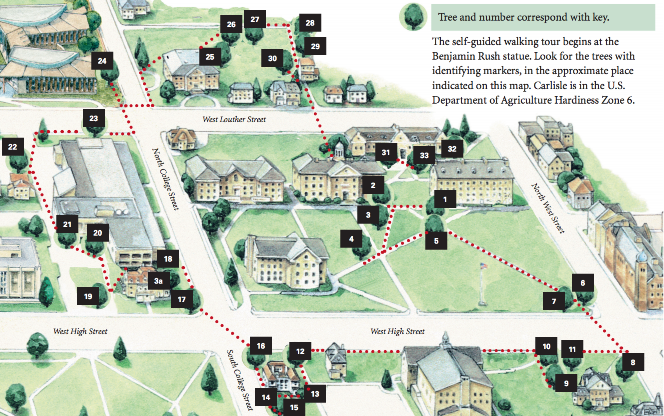Choose Your Own Adventure with Self-Guided Tree Tour
As Pennsylvania enters peak foliage season, the Dickinson community can take advantage of a self-guided tour of the campus’s most impressive trees, designed by campus arborist Mark Scott.
According to Scott, the tour was already in the works when he arrived seven years ago, and he has helped finalize it, route it and pick some additional trees. The tour currently includes 33 trees, but the Facilities team is working to expand the route to include more than 60 species.
Scott says that the tour “highlights some of the different trees that we have on campus, some of the more interesting things. Like some of the larger trees that we have on campus and some that were picked for their characteristics, such as their flowering, their bark and their winter interest.”
Scott thinks that the most interesting tree is the Shumard oak “located at the northwest corner of Drayer.” He finds “it most interesting due to the form and size of the plant.”
The tour map is available on as a PDF download from Dickinson’s website. The map includes short descriptions of each tree, including the height of the tree, the growth rate and facts that are unique to the species of tree.
The tour incorporates multiple parts of Dickinson’s campus including trees around the academic quad, across the street around Weiss, around the HUB and then ending near Dana. According to the map, the trees all have identifying markers to correspond with the number on the map.
Scott says that he and other Facilities staff members are “working on expanding the tree tour to include a second loop which would expand it to over 60 different species to see. It will take in different parts of campus such as the HUB campus and Morgan Field and almost double the tour in size.” Scott says they must finalize the route and order tree marker tags before they can publish a new map.
“I did a pencil and paper list of the different species that we have on campus, and we have over 140 different species on campus,” Scott said. “So that’s quite a diverse population of trees that are on campus; we have almost 1,100 trees.” Many of the trees are located on Dickinson-owned property away from the main campus area.
Scott says that the Building and Grounds Department keeps track of all the trees with a GIS inventory database. There are already 1,100 trees in the database, and Scott estimates they will add “another 400-500 more, which hopefully, by winter, it will all be completed.” He says that adding the additional trees will create a comprehensive inventory of all the trees on campus.
According to GIS Geography, “geographic information system [GIS inventory] is a computer-based tool that analyzes, stores, manipulates and visualizes geographic information on a map.”
“I think the tour is very interesting and unique to Dickinson’s culture,” said Katherine Nirenberg ’16. “I like that students and faculty care about the small things that make our campus special.”
Scott was not sure how many people have actually taken the tour since it is self-guided. He estimates that the tour that “takes about an hour to hour and a half to complete.”
For more information about the tree tour go to http://www2.dickinson.edu/departments/facilities/campustrees.htmlpage.






